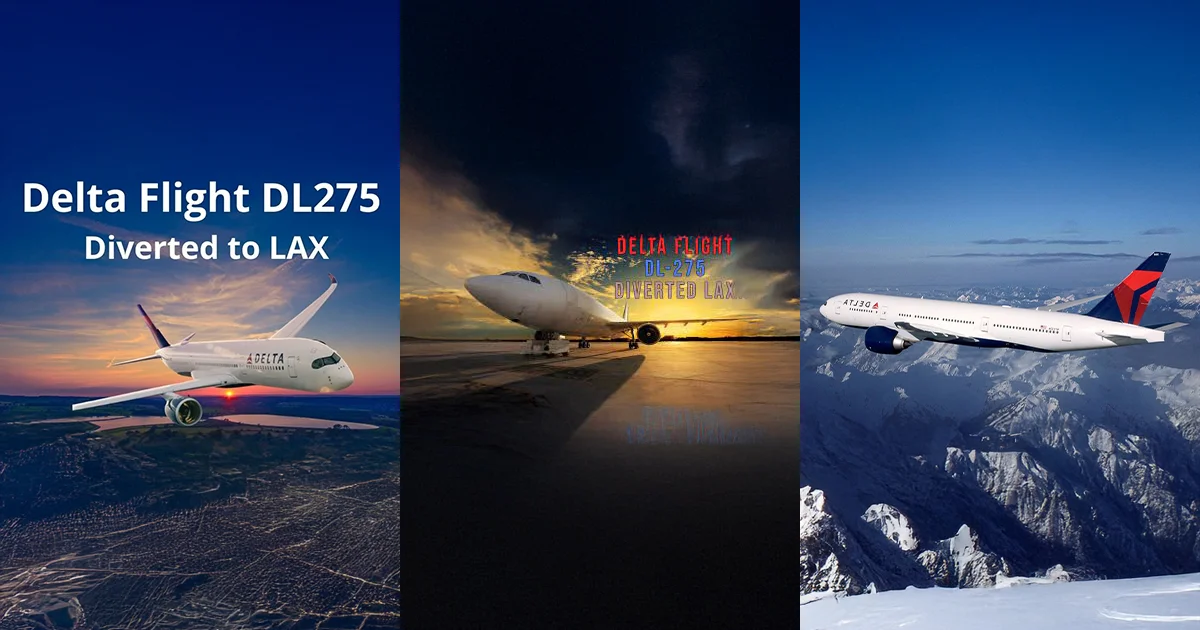Imagine getting on a long-haul flight being prepared to get to where you need to arrive safely. The captain suddenly says that they are diverting. This is what occurred in the Delta Flight DL275 diversion at LAX, and the passengers were placed in distress, but no lives were lost. We know air travel is designed to be safe, but when unexpected events occur, questions arise. Why was the flight diverted? What protocols were followed? And most importantly, what can we, as travelers, learn from this? Let’s dive into the full story of Delta Flight DL275 Japan diversion LAX and see how aviation safety played out.
What Triggered the Delta Flight DL275 Diversion?
The incident began when Delta Flight 275 experienced a technical issue mid-air. While en route from Asia to the United States, pilots detected irregularities in the anti-ice system of the Airbus A350. This system is crucial during high-altitude operations because it prevents ice buildup on engine components. At 38,000 feet, failure of this system increases risks.
The crew acted swiftly. Using aviation safety models like FORDEC (Facts, Options, Risks, Decision, Execution, Check), they evaluated every possibility. Returning to the departure point would take hours over isolated terrain. Therefore, Los Angeles International Airport (LAX) became the best option.
Key considerations included:
- Proximity: LAX was closer than other airports like Anchorage or Seattle.
- Facilities: LAX has world-class runways, technical support teams, and emergency resources.
- Passenger Care: The airport could handle rebooking, meals, and accommodations.
Thus, the decision to divert Delta Flight DL275 to LAX today was not only logical but lifesaving.
Passenger Experience During the Diversion
Passengers on board experienced a rollercoaster of emotions. At the beginning, lots of people did not know the technical problem. Flight attendants were out talking, trying to assure travelers that safety was the primary goal. When word of the diversion spread through the cabin, it was received in different ways.
- Some passengers were happy to realize that safety was a priority.
- Some of the complaints involved missed connections and delays.
- Other people would call their families and talk to them so that they could be assured.
Professionalism was reflected at Delta despite the pressure. When it landed, medical teams, maintenance crews and even customer service representatives were on hand. Customers had been provided with rebooking support, hotels and meals.
This transparent and empathetic approach helped maintain trust. Ultimately, the Delta Flight DL275 Japan diversion LAX became an example of how airlines manage emergencies while protecting passengers.
Why LAX Was the Ideal Diversion Choice
We might wonder why the pilots chose LAX instead of another closer airport. The answer lies in infrastructure and readiness.
- Technical Support: LAX has Rolls-Royce teams that can service the Airbus A350.
- Medical Facilities: Nearby hospitals provide rapid care if necessary.
- Operational Strength: With many runways and excellent navigation aids, emergency operations go well.
- Weather Conditions: At the time of the diversion, the weather at LAX permitted a safe landing.
In aviation, every decision is based on minimizing risks. By selecting LAX the pilots ensured that passengers received not only safety but also comfort. This highlights why the Delta Flight DL275 diverted LAX incident is a valuable case study in risk management.
The Ripple Effect on Flights and Operations
A diversion not only impacts one flight. When Delta Flight 275 landed at LAX, it disrupted schedules for hundreds of travelers. Connecting flights had to be rescheduled, and airport traffic increased.
Delta covered additional expenses, including:
- Fuel for the diversion route.
- Hotel stays and meals for delayed passengers.
- Aircraft maintenance checks.
Industry experts estimate that diversions like this can cost airlines millions. However, airlines know safety outweighs cost. Just like the United Airlines Flight UA770 emergency diversion and the United Airlines Flight UA770 emergency diversion status case, Delta’s priority was clear: keep everyone safe, even at a high operational cost.
Lessons for Travelers and the Aviation Industry
The Delta Flight DL275 diverted LAX story carries key lessons:
- Passenger safety: Airlines do not put passenger safety second.
- Crew training issues: Calm communication inspires confidence in the passengers.
- Powerful hubs save lives: Major airports such as LAX are surpassing other airports in their emergency services.
- Civilized cooperation is important: The cooperation of calm people and following instructions will enable a smoother process.
As travelers, the biggest lesson here is that diversions are not a form of failure but a form of active protection. Companies such as Delta and United Airlines explain that diversions are annoying in terms of planning, but they ensure that passengers are safe.
Conclusion: A Safe Landing with Valuable Insights
The diversion of Delta Flight DL275 to LAX brings us to the aviation ultimate rule, which is safety first. People were not in danger as passengers encountered delays and disorder. Everything went smoothly, to achieve security, including crew decision-making and LAX’s strong infrastructure
As with Delta Flight DL275 Japan diversion LAX and similar events, we should view diversions not as failures but as proof of aviation’s resilience. Airlines may bear heavy costs, but passengers gain confidence knowing safety always takes priority. Next time we hear about a diversion, let’s remember: it is not just an inconvenience. It is a lifesaving choice.
FAQs About Delta Flight DL275 Diversion
Q1: Why was Delta Flight DL275 diverted to LAX?
The Airbus A350 had an anti-ice system issue. The crew diverted to LAX for safety and technical support.
Q2: Was anyone injured during the diversion?
No. Passengers landed safely. Medical staff were on standby, but no injuries were reported.
Q3: How did Delta handle passengers after the diversion?
Delta provided rebooking, hotel rooms, and food vouchers to support passengers until new flights were arranged.
Q4: How common are flight diversions like this?
Diversions are rare but routine in aviation safety. They occur due to technical, medical, or weather-related issues.
Q5: How does this compare with the United Airlines UA770 case?
Similar to United Airlines Flight UA770’s emergency diversion, Delta prioritized safety first, proving standard protocols work effectively.



